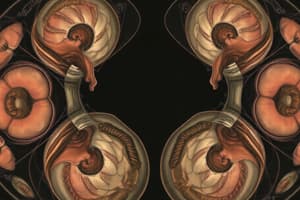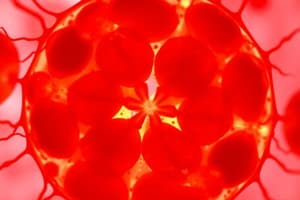Podcast
Questions and Answers
What must happen to a chromosome before a cell starts mitosis?
What must happen to a chromosome before a cell starts mitosis?
The single DNA molecule in the chromosome must be replicated.
Which of the following phases make up the stages of mitosis?
Which of the following phases make up the stages of mitosis?
- Telophase (correct)
- Prophase (correct)
- Anaphase (correct)
- Prometaphase (correct)
- Metaphase (correct)
Which of the following events characterizes metaphase of mitosis?
Which of the following events characterizes metaphase of mitosis?
Alignment of the chromosomes at the equator.
During the entirety of which stage of the cell cycle did the nucleus contain 6 pg of DNA?
During the entirety of which stage of the cell cycle did the nucleus contain 6 pg of DNA?
Asexual reproduction _____
Asexual reproduction _____
What number and types of chromosomes are found in a human somatic cell?
What number and types of chromosomes are found in a human somatic cell?
For what purpose(s) might a karyotype be prepared?
For what purpose(s) might a karyotype be prepared?
In alternation of generations, what is the diploid stage of a plant that follows fertilization called?
In alternation of generations, what is the diploid stage of a plant that follows fertilization called?
How are sister chromatids and homologous chromosomes different from each other?
How are sister chromatids and homologous chromosomes different from each other?
Why do some species employ both mitosis and meiosis, whereas other species use only mitosis?
Why do some species employ both mitosis and meiosis, whereas other species use only mitosis?
Human gametes are produced by _____
Human gametes are produced by _____
Normal human gametes carry _____ chromosomes.
Normal human gametes carry _____ chromosomes.
Which of these cells is (are) haploid?
Which of these cells is (are) haploid?
A diploid organism whose somatic cells each contain 32 chromosomes produces gametes containing _____ chromosomes.
A diploid organism whose somatic cells each contain 32 chromosomes produces gametes containing _____ chromosomes.
Meiosis I produces _____ cells, each of which is _____.
Meiosis I produces _____ cells, each of which is _____.
Meiosis II typically produces _____ cells, each of which is _____.
Meiosis II typically produces _____ cells, each of which is _____.
During _____ sister chromatids separate.
During _____ sister chromatids separate.
At the end of _____ and cytokinesis, haploid cells contain chromosomes that each consist of two sister chromatids.
At the end of _____ and cytokinesis, haploid cells contain chromosomes that each consist of two sister chromatids.
Synapsis occurs during _____.
Synapsis occurs during _____.
Homologous chromosomes migrate to opposite poles during _____.
Homologous chromosomes migrate to opposite poles during _____.
During _____ chromosomes align single file along the equator of a haploid cell.
During _____ chromosomes align single file along the equator of a haploid cell.
At the end of _____ and cytokinesis there are four haploid cells.
At the end of _____ and cytokinesis there are four haploid cells.
During _____ a spindle forms in a haploid cell.
During _____ a spindle forms in a haploid cell.
In diploid cells: mitosis results in the formation of how many cells; meiosis results in the formation of how many cells?
In diploid cells: mitosis results in the formation of how many cells; meiosis results in the formation of how many cells?
Which of the following occurs during meiosis but not during mitosis?
Which of the following occurs during meiosis but not during mitosis?
What is crossing over?
What is crossing over?
Part A Meiosis Terminology
Part A Meiosis Terminology
Part B Interactions Among Chromosomes
Part B Interactions Among Chromosomes
Part C Animal Life Cycles
Part C Animal Life Cycles
Part B crossing over
Part B crossing over
The parent cell that enters meiosis is diploid, whereas the four daughter cells that result are haploid.
The parent cell that enters meiosis is diploid, whereas the four daughter cells that result are haploid.
Video Tutor Quiz Part A
Video Tutor Quiz Part A
Video Tutor Quiz Part B
Video Tutor Quiz Part B
Video Tutor Quiz Part C
Video Tutor Quiz Part C
Video Tutor Quiz Part D
Video Tutor Quiz Part D
Video Tutor Quiz Part E
Video Tutor Quiz Part E
Which processes lead to most genetic variation in sexually reproducing organisms?
Which processes lead to most genetic variation in sexually reproducing organisms?
Which of these gametes contains one or more recombinant chromosomes?
Which of these gametes contains one or more recombinant chromosomes?
Root Words Part A
Root Words Part A
Root Words Part B
Root Words Part B
The shuffling of chromosomes that occurs during both fertilization and _____ can lead to genetic variation.
The shuffling of chromosomes that occurs during both fertilization and _____ can lead to genetic variation.
Heritable variation is required for which of the following?
Heritable variation is required for which of the following?
Part A - Processes that determine heredity and contribute to genetic variation
Part A - Processes that determine heredity and contribute to genetic variation
Part B - Independent assortment and genetic variation
Part B - Independent assortment and genetic variation
Assume that an organism exists in which crossing over does not occur, but all other processes associated with meiosis occur normally. If crossing over did not occur, which of the following statements about meiosis would be true?
Assume that an organism exists in which crossing over does not occur, but all other processes associated with meiosis occur normally. If crossing over did not occur, which of the following statements about meiosis would be true?
This cell is diploid.
This cell is diploid.
The cell is diploid because it contains two sets of chromosomes.
The cell is diploid because it contains two sets of chromosomes.
The two chromatids were formed by duplication of a chromosome.
The two chromatids were formed by duplication of a chromosome.
Two sister chromatids are joined at the centromere prior to meiosis. Which statement is correct?
Two sister chromatids are joined at the centromere prior to meiosis. Which statement is correct?
Flashcards are hidden until you start studying
Study Notes
Mitosis Overview
- Chromosomes must be replicated before a cell enters mitosis.
- Stages of mitosis include prophase, prometaphase, metaphase, anaphase, and telophase.
- During metaphase, chromosomes align at the cell's equator.
- G2 phase is when a nucleus contains 6 picograms (pg) of DNA.
Asexual Reproduction
- Produces offspring that are genetically identical to the parent organism.
Human Chromosome Structure
- A human somatic cell contains 44 autosomes and 2 sex chromosomes.
- Normal human gametes carry 23 chromosomes.
Karyotype Applications
- Karyotypes can be prepared for various genetic analyses including chromosomal abnormalities.
Alternation of Generations in Plants
- The diploid stage following fertilization is known as the sporophyte.
Chromosome Types
- Homologous chromosomes share the same gene loci but may have different alleles.
- Sister chromatids are identical copies formed during DNA replication.
Reproductive Cell Division
- Species that produce plant gametes utilize both mitosis and meiosis.
- Human gametes are produced through meiosis, involving two rounds of cell division which yield haploid cells.
Meiosis Details
- A diploid organism with 32 chromosomes produces haploid gametes with 16 chromosomes.
- Meiosis I results in two haploid cells, while meiosis II generates four haploid cells.
- Synapsis occurs during prophase I, and crossing over is the exchange of homologous chromatid portions.
- Homologous chromosomes move to opposite poles during anaphase I.
Genetic Variation in Meiosis
- Crossing over, random fertilization, and independent chromosome assortment contribute to genetic diversity.
Life Cycle and Chromosome Interaction
- Fertilization results in diploid (2N) zygotes which undergo mitosis.
- Heritable variation is essential for evolutionary processes.
Root Words in Genetics
- Prefixes like "poly-" (many) and "hetero-" (different) are common in genetic terminology.
Misconceptions about Cells
- Diploid cells consist of two sets of chromosomes, while sister chromatids are identical prior to meiosis.
Overall Importance of Meiosis
- Without crossing over, genetic variation among gametes would be reduced, emphasizing the role of meiosis in generating diversity.
Studying That Suits You
Use AI to generate personalized quizzes and flashcards to suit your learning preferences.




